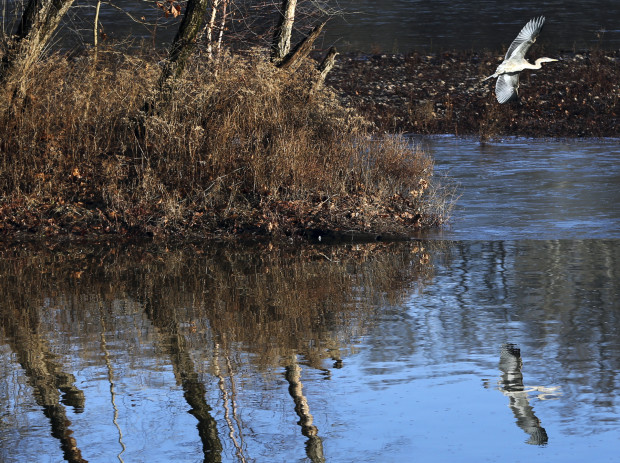Delaware basin conservation law resilient to any Trump rollbacks, supporters say
-
Jon Hurdle

Mel Evans / AP Photo
A heron takes flight along the Delaware River in the early morning light Sunday, Dec. 25, 2016, in Washington Crossing, Pa.
Supporters of a new law that provides federal support for conservation in the Delaware River Basin predicted that the measure won’t be derailed by any efforts by the incoming Trump administration to roll back environmental protections.
Despite concerns in the environmental community that Trump will dismantle major initiatives such as the Clean Power Plan and America’s commitment to the Paris climate accord, backers of the Delaware River Basin Conservation Act argued that the strong bipartisan support for the law suggests that it will get the funding and technical help that it needs from Washington.
“The broad bipartisan support for this, and the legacy of and history of activity on the watershed I think is going to protect it,” said U.S. Representative Patrick Meehan, a Pennsylvania Republican who voted for the bill, and appeared at a press conference on Thursday to mark the signing of the bill by President Obama just before Christmas.
The law directs the U.S. Fish and Wildlife Service to coordinate the efforts of state and federal agencies, universities and local nonprofits to protect water quality, improve flood control, manage fish stocks and improve public access to the region between upstate New York and the Delaware Bay.
The bill’s signing into law concluded a legislative battle that began in 2010 to get federal recognition for a watershed that provides drinking water to some 15 million people.
Meehan said the law seems likely to be implemented if U.S. Rep. Ryan Zinke is confirmed as Secretary of the Interior.
“I’m encouraged by Ryan Zinke being nominated for Secretary of the Interior,” Meehan said in an interview. “He is a guy who has demonstrated in the past support for these kinds of things.”
Asked whether funding for the law could be held up by the Republican-controlled Congress, Meehan said he is “hopeful” that Congress will support its implementation, particularly in light of the fact that much of the conservation work already underway in the Basin is being done by private nonprofits.
“A lot of what happens here isn’t governmental,” he said. “It’s the collaboration of many organizations and groups that are looking for things that can be done. That shouldn’t be controversial. Keeping water clean – that’s not a partisan issue.”
Meehan also argued that the goal of improving the environmental quality of the Delaware Basin would not be set back if the Trump administration scraps the controversial Waters of the U.S. Rule, which expands the scope of federally protected waters to include minor waterways such as ponds, ditches and tributaries. Republicans strongly opposed the measure when it was rolled out by President Obama, and Trump promised during the election campaign he would dump it.
Meehan said that any termination of the rule would not interfere with better protection of the Basin because the conservation act creates federal protection for the main watershed rather than smaller water bodies. “We’re really talking about a lot of activity that is closely associated with a flowing river and there are already well-identified connections to the tributaries,” he said.
Jennifer Adkins, executive director of the Partnership for the Delaware Estuary, one of the groups that will cooperate with the FWS, said there is strong support for conservation of the Basin, as shown by the passage of the new law, and by the existence of non-governmental efforts including the Delaware River Watershed Initiative, led by the William Penn Foundation.
“There seem to be some kind of convergence, and getting this program in place will better leverage all of those things, and to not take advantage of that opportunity would be a very bad decision,” Adkins said after Thursday’s event.
“It would be dishonest to say that there’s no concern because I think there’s a lot of concern about a lot of the work that we do,” she said. For example, PDE gets funding from EPA, which is often attacked by Congressional Republicans.
Michael Slattery, a FWS official who will lead coordination of around 100 conservation groups, also argued that the broad-based political support for the law augurs well for its implementation.
“This is about a unity of purpose that is grounded on an appreciation for fish, wildlife and habitat for the benefit of people who live in the watershed,” he said. “There’s been no negative sentiment expressed about those kinds of values.”
The first major result of the new partnership will be a watershed-wide map of interconnected habitat that can be resilient in the face of adverse influences such as major storms or development pressures. The map is due to be completed within six months, he said.
The idea of the map is to show which areas will survive such changes, and which will be worthy of protection “so that we can be confident that the investments we’re making will be lasting,” Slattery said.
















